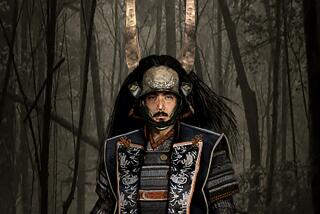THE POWER OF NOH TO AWAKEN
WASHINGTON — After 600 years, Noh dance-drama may no longer be the Shoguns’ “official entertainment for convivial occasions, for recreation and for the security of the world,” but it still has the power to awaken a sense of mono no aware : the sadness and pity in all things.
Thus, Southern California residents who thought Kabuki at UCLA last year was the ultimate Japanese theatrical experience may have another think coming Monday and Tuesday when the Japan America Theatre presents a star-studded troupe of 22 Noh and Kyogen performers.
A number of people will go to the theater to catch a glimpse of the handsome 20-year-old Kyogen actor Takeshi Nomura, who recently starred in Akira Kurosawa’s movie “Ran” as Tsurumaru, the blinded noble. However, the star of the troupe is Sadayo Kita, who at 59 is already an official “Intangible Cultural Asset” (his next honor doubtless will be designation as “Living National Treasure”). By birth and achievement he is destined to become the 16th head of the Kita School.
“I have been many times abroad,” Kita explained before a performance here this week. “In fact, I was in the Noh group that went to Italy in 1954, the first Noh that ever left Japan. In Europe, people are proud of the age of their own culture and are a little sensitive to Noh’s greater antiquity, although they’re very flattering to your face. America embraces us more warmly, because it is young and open to the new, no matter where it comes from.
“Each time we come here, we play in more places and more people see us. This time I am doing ‘Aoi no Ue,’ a play I have wanted to do in America for a long time . . Only now has it become possible.”
Kita, his hair slightly graying around his aristocratic countenance, looks directly at his visitor as he explains his art. Disappointment crosses his face when he speaks of “The Beauty of Noh,” a film he and Kurosawa were making. “We ran out of money,” he says. “We shot on location for a while, but then . . . Kurosawa’s sponsors are afraid of his extravagances. But I’m sure the movie will be finished one day.
“It’s dangerous for Noh or Kyogen actors to make movies--they may never come back to the stage because of the fame and money. I was offered a film role once, but my father wouldn’t let me take it.”
And with this he finishes his coffee and leaves for his next appointment, a lecture demonstration in Maryland. He is not only a major artist, but an eternal propagandist.
For antiquarians, Noh (an obsolete word that means “ability” or “accomplishment”) is cause for celebration. It is the oldest professional theater form in the world to be still presented more or less as originally staged.
To the drama lover, Noh can provide the astonishment of “the light of the sun at midnight” or “the white purity of snow lying on a silver garden,” as one 14th-Century treatise on aesthetics described its effect and affect.
Beginning in 1374, it served as the authorized ceremonial drama of the samurai until 1868 when feudalism was abolished and Noh, without the support of aristocrats, went underground for decades.
During its long period under noble protection, Noh refined itself into a subtle perfection of indirection and allusion. Realism, or monomane (imitation of things as they are), faded as Noh focused more and more on Zen’s mindlessness or “no action.”
In the course of this long existence, five separate schools sprung up, each with dozens of instructional branches and some with as many as 1 million pupils. The Kita School is the youngest, dating back only to 1618. The differences between schools are largely imperceptible; each boasts particular touches of “elegance and color,” a line change here and a gestural accent there.
Few Noh plays last as long as an hour. There is no scenery. When the chorus onstage sings that the cherry tree is in blossom, the spectator must see it on the empty stage. There’s no makeup for unmasked actors who are determinedly expressionless.
Painted wooden masks, many of them national treasures of carving, step at once toward and away from verisimilitude. These have been fashioned into a kind of neutral extreme expressing both joy and sorrow, and are worn only by women, ghosts, demons or old men.
The merest tilt of the head makes a mask smile, grieve or ponder in wonderment. The actor behind the mask speaks or intones in his normal voice, rendered hollow and bodiless as an echo. Gestures--and Noh is as much dance as it is theater--are fixed and immutable, as if compressed into pinpoints of explosions.
In walking, the heel barely leaves the floor and the forepart of the foot rises and quickly falls in measured steps, two or three of which may mean a journey of a hundred miles.
Despite the theatrical economy, Noh’s costumes are gorgeously elaborate. Even the Old Woman of the Mountain (Yamamba), who lives in penury in legend, on stage is caparisoned in luxurious gold and silver brocade.
One caution: Get--beg, borrow or steal--translations of the plays and do as knowledgeable Japanese do: Follow the stage action with half an eye cocked on the text. This way, you will find the ritual atmosphere, where Buddhist pollen powders every word, almost suffocating in its intensity of thought.
As for Kyogen, less preparation is needed. These are immediate, comic interludes originally designed to relieve Noh’s austerity. The situations are universal: The wicked get their comeuppance, servants outwit masters, women beat men at their own game.
Being considered “unworthy comedies,” the playlets were not written down until the 17th Century, so the language is considerably easier to follow than Noh’s ringing archaisms.
More to Read
The biggest entertainment stories
Get our big stories about Hollywood, film, television, music, arts, culture and more right in your inbox as soon as they publish.
You may occasionally receive promotional content from the Los Angeles Times.










